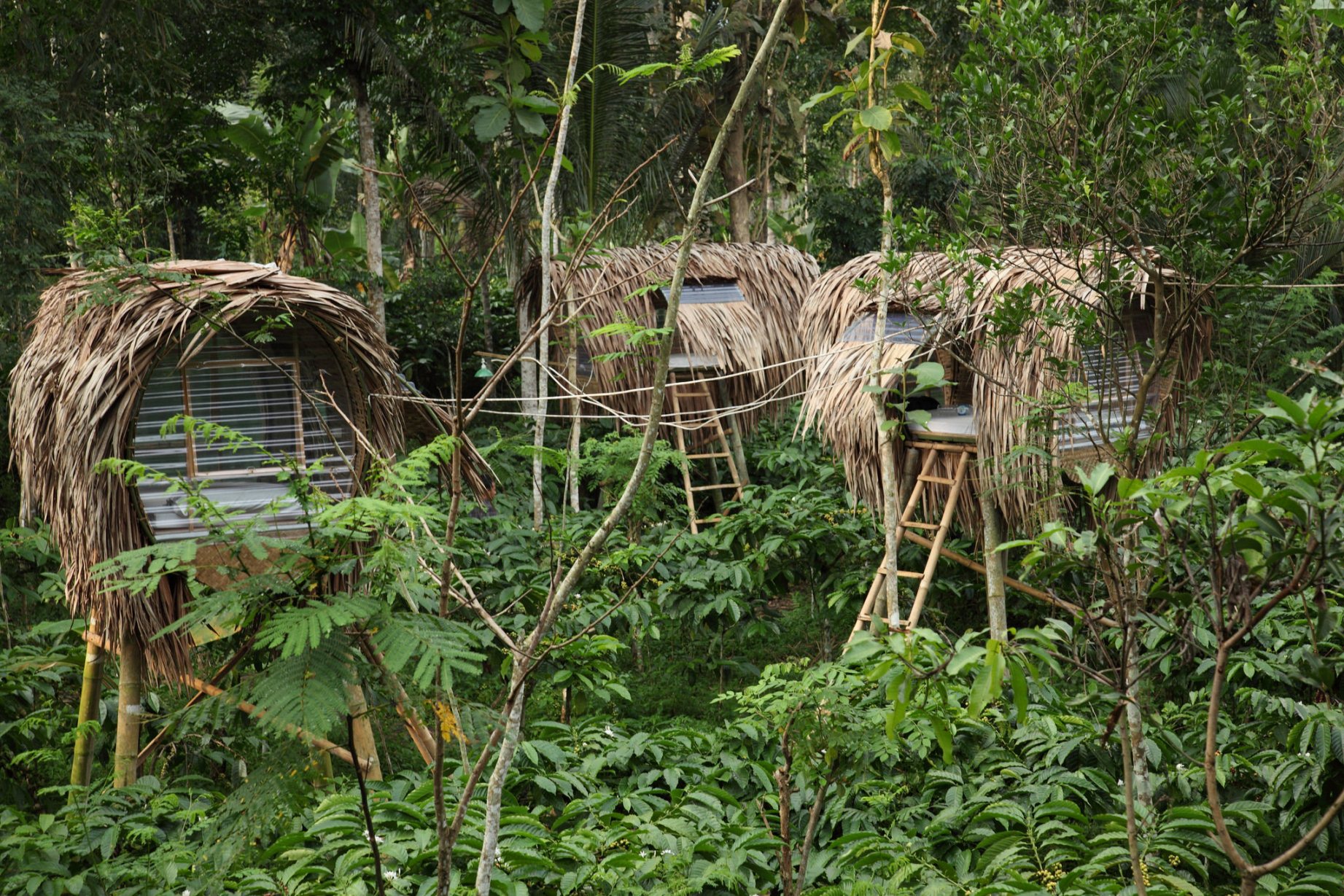The cocoon homestay houses, designed by Errik Irwan and constructed by Muslih Nu, blend into the surroundings of Kandangan coffee plantation in Central Java - Jessica Lea Dunn
Indeed one of the motivations of this edition of Inside Indonesia has been to make Indonesian design more visible. The resulting collection of articles also challenges the definitions and boundaries of design as they shift in global discourse.
This issue brings together instances of participatory design, design action, citizen design, design thinking and social design that are specific to local Indonesian contexts. This includes the development of new processes that address overtly social, environmental and political issues as well as the employment of design forms that can make political statements. In some ways design is considered in this edition as a form of activism, a movement that resists the ‘better, faster, cheaper’ mantra of neoliberalism, anticipates uncertain futures and responds to the immense challenges of urbanisation, poverty and climate change.
The edition opens with a visually rich essay by Jessica Lea Dunn exploring the work of legendary product designer Singgih Kartono. From his iconic wooden Magno wooden radio to his bamboo bicycles, Kartono’s designs focus on community needs, local economies, and sustainable resource use. His manufacturing methods model an alternative to large scale production in urban factories while challenging the inevitability of mass urbanisation by firmly placing design practice and business in a village context.
The next article also addresses urbanisation but turns our focus to the role of architects in ensuring that kampung upgrades address the needs of residents through participatory design practices. Muhammad Kamil describes how for socially concerned architects, such as Romo Mangunwijaya, design has come to include immaterial processes that facilitate new forms of interaction. Here architects ‘facilitate’ the design of kampung structures and systems, directed and implemented by residents themselves. The opening up of such processes to participation means that design can be a form of resistance to eviction, rather than fait accompli in the development process.
Further questions challenging the traditional role of architecture are taken up by Amanda Achmadi and Agung Sentausa. They propose that, in the face of rising religious intolerance, design plays a role in ensuring peaceful everyday interactions within diverse urban populations. Their analysis shows how Jakarta’s malls are in part about consumerism but also contribute to the continual reorientation of religious identities that is so important to Indonesian society.
Also exploring the issue of religious expression, farid rakun reveals an unexamined history of vernacular graphic design in Jakarta by linking the production of urban stickers to urban semiotics. As with the design of shopping malls, the design of image and text combinations in these tiny canvases has provided necessary space for the interplay of seemingly incongruent messages of religion and popular culture.
Sybrand Zijlstra takes a step back to look at a local application of the idea of design thinking, that is, applying design approaches and methods outside design situations. He points to the example of the Bandung Creative City Forum which has been using an ‘urban acupuncture’ approach to connect local neighbourhoods with Mayor Ridwan Kamil’s broader ‘creative city’ initiatives.
We then move to Yogyakarta, where Malcolm Smith looks at how artists are using their skills in graphics, fashion, textiles and product design to create merchandise that is sustaining their arts practices while bringing critical dimensions to contemporary design products. These design practices speak to the particular pressures felt by young Indonesian artists working in a highly commercialised art as pointed out by Adrian Vickers in his editorial for Inside Indonesia’s most recent visual arts edition (/what-is-contemporary-indonesian-art-3).
Continuing in the fertile territory between art and design practices, Rebecca Conroy chats with cross-disciplinary artist Andreas Siagian about how social design can facilitate DIY education. Siagian’s work always begins with curiosity, demonstrated by his recent ‘wine project’ about local alcohol manufacture. By working with communities in ways that intersect science, art and design, he says, new forms of knowledge are created and circulated.
The articles in this edition reveal a diversity of approaches taken up by Indonesia’s contemporary designers and architects. Each identifies design practice as force of change and contributes to a broad spectrum of design activism. The critical question is not whether design is political or not, but what kind of politics does design do?
Alexandra Crosby is a lecturer in Interdisciplinary Design Studies at the University of Technology, Sydney. She runs a ‘Global Studio’ in Jakarta with the aim of facilitating collaborations between young designers in Australia and Indonesia.
